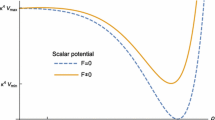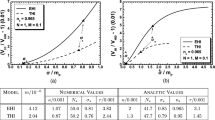Abstract
We investigate the effects of logarithmic corrections to the minimal Kähler potential in supergravity. They provide a constant Fayet–Iliopoulos term, but can induce singularities in the “F-term” scalar potential. If a proper superpotential is supplemented, such singularities can be avoided at the minimum of the scalar potential and the relevant U(1) gauge symmetry as well as supersymmetry can be broken. We apply this mechanism to a D-term hybrid inflationary model such that the U(1) gauge symmetry is broken during the inflation era and the resultant cosmic strings are diluted away. We employ a non-minimal form of the gauge kinetic function that includes an inflaton’s contribution such that the spectral index in the minimal D-term inflationary model is cured to the observed value. The tensor-to-scalar ratio is extremely small.
Similar content being viewed by others
Notes
With the inclusion of soft SUSY breaking effects, however, \(\phi _0\) and \(\phi _{+(-)}\) can also develop small non-zero vacuum expectation values (VEVs).
It is possible, e.g., due to high-temperature effects before inflation starts in the universe.
Because the gauge kinetic function depends on \(\phi _0\), the size of the U(1)\(_G\) gauge coupling constant and \(V_\mathrm{inf}\) will be affected additionally by \(\phi _0\) via \(g^2\) [except the effect from the overall factor of Eq. (7)]. However, we neglect such an effect with the assumption \(c_0~\mathrm{Re}\phi _0^2/M_P^2\ll 1\). This assumption turns out to be consistent, as seen in Eq. (10).
Were it not for the \(\lambda \) term in the superpotential, an accidental U(1) symmetry under which only \(\phi _\pm \) are charged survives even if U(1)\(_G\) is broken by \(\Phi _\pm \ne 0\).
Note that we set the logarithmic terms for \(\phi _{\pm ,0}\) in the Kähler potential are set to be zero in order to keep the main story of the minimal D-term inflationary model. If we turn on such terms, the first line of the scalar potential in (28) is modified approximately as \(\zeta ^2(\Phi ,\phi )\left[ \left\{ |y|^2|\phi _0|^2\left( |\phi _+|^2+|\phi _-|^2\right) +|y|^2|\phi _+\phi _-|^2\right\} \left| 1+ \tilde{\epsilon }(M\Phi _+\Phi _-/y\phi _0\phi _+\phi _-)\right| ^2 +M^2\left( |\Phi _+|^2+|\Phi _-|^2\right) \right] \), where \(\xi \)s associated with \(\phi _{\pm ,0}\) (\(\equiv \tilde{\xi }_i\), \(i=+,-,0\)) are set to the same, \(\tilde{\xi }_i/M_P^2\equiv \tilde{\epsilon }\) for simplicity, and \(\zeta ^2(\Phi ,\phi )\) is defined as \(\zeta ^2(\Phi )\times (|\phi _+|^2/M_P^2)^{\tilde{\epsilon }}(|\phi _-|^2/M_P^2)^{\tilde{\epsilon }}(|\phi _0|^2/M_P^2)^{\tilde{\epsilon }}\) [39]. In this case, \(y\phi _0\phi _+\phi _-\approx -\tilde{\epsilon }M\Phi _+\Phi _-\) should be satisfied at the minimum for \(\phi _0\gtrsim |M/y|\). Namely, \(\phi _\pm \ne 0\) is allowed during inflation. This correction turns out to leave intact (19) on such a trajectory.
References
For a review, see e.g. D.H. Lyth, A. Riotto, Phys. Rep. 314, 1 (1999). arXiv:hep-ph/9807278
H.P. Nilles, Phys. Rep. 110, 1 (1984)
G.R. Dvali, Q. Shafi, R.K. Schaefer, Phys. Rev. Lett. 73, 1886 (1994). https://doi.org/10.1103/PhysRevLett.73.1886. arXiv:hep-ph/9406319
E.J. Copeland, A.R. Liddle, D.H. Lyth, E.D. Stewart, D. Wands, Phys. Rev. D 49, 6410 (1994). arXiv:astro-ph/9401011
K. Kumekawa, T. Moroi, T. Yanagida, Prog. Theor. Phys. 92, 437 (1994). arXiv:hep-ph/9405337
C. Panagiotakopoulos, Phys. Rev. D 55, 7335 (1997). arXiv:hep-ph/9702433
A.D. Linde, A. Riotto, Phys. Rev. D 56, 1841 (1997). arXiv:hep-ph/9703209
C. Panagiotakopoulos, Phys. Lett. B 402, 257 (1997). arXiv:hep-ph/9703443
See also B. Kyae, Q. Shafi, Phys. Lett. B 635, 247 (2006). https://doi.org/10.1016/j.physletb.2006.03.007. arXiv:hep-ph/0510105
B. Kyae, Q. Shafi, Phys. Rev. D 72, 063515 (2005). https://doi.org/10.1103/PhysRevD.72.063515. arXiv:hep-ph/0504044
B. Kyae, Q. Shafi, Phys. Lett. B 597, 321 (2004). https://doi.org/10.1016/j.physletb.2004.07.030. arXiv:hep-ph/0404168
M. Kawasaki, M. Yamaguchi, T. Yanagida, Phys. Rev. Lett. 85, 3572 (2000). https://doi.org/10.1103/PhysRevLett.85.3572. arXiv:hep-ph/0004243
K.Y. Choi, B. Kyae, Phys. Rev. D 90(2), 023536 (2014). https://doi.org/10.1103/PhysRevD.90.023536. arXiv:1404.7855 [hep-th]
K.Y. Choi, B. Kyae, Phys. Lett. B 735, 391 (2014). https://doi.org/10.1016/j.physletb.2014.06.053. arXiv:1404.3756 [hep-ph]
K.Y. Choi, B. Kyae, Phys. Lett. B 706, 243 (2012). https://doi.org/10.1016/j.physletb.2011.11.045. arXiv:1109.4245 [astro-ph.CO]
K.Y. Choi, S.A. Kim, B. Kyae, Nucl. Phys. B 861, 271 (2012). https://doi.org/10.1016/j.nuclphysb.2012.04.004. arXiv:1202.0089 [astro-ph.CO]
P. Binetruy, G.R. Dvali, Phys. Lett. B 388, 241 (1996). https://doi.org/10.1016/S0370-2693(96)01083-0. arXiv:hep-ph/9606342
P. Fayet, J. Iliopoulos, Phys. Lett. 51B, 461 (1974). https://doi.org/10.1016/0370-2693(74)90310-4
Y. Akrami et al. [Planck Collaboration], arXiv:1807.06211 [astro-ph.CO]
P. Binetruy, G. Dvali, R. Kallosh, A.V. Proeyen, Class. Quantum Gravity 21, 3137 (2004). https://doi.org/10.1088/0264-9381/21/13/005. arXiv:hep-th/0402046
F. Catino, G. Villadoro, F. Zwirner, JHEP 1201, 002 (2012). https://doi.org/10.1007/JHEP01(2012)002. arXiv:1110.2174 [hep-th]
C. Wieck, M.W. Winkler, Phys. Rev. D 90(10), 103507 (2014). https://doi.org/10.1103/PhysRevD.90.103507. arXiv:1408.2826 [hep-th]
Z. Komargodski, N. Seiberg, JHEP 0906, 007 (2009). https://doi.org/10.1088/1126-6708/2009/06/007. arXiv:0904.1159 [hep-th]
K.R. Dienes, B. Thomas, Phys. Rev. D 81, 065023 (2010). https://doi.org/10.1103/PhysRevD.81.065023. arXiv:0911.0677 [hep-th]
K. Nakayama, K. Saikawa, T. Terada, M. Yamaguchi, JHEP 1605, 067 (2016). https://doi.org/10.1007/JHEP05(2016)067. arXiv:1603.02557 [hep-th]
M.B. Green, J.H. Schwarz, Phys. Lett. B 149, 117 (1984)
M. Dine, N. Seiberg, E. Witten, Nucl. Phys. B 289, 589 (1987)
J. Atick, L. Dixon, A. Sen, Nucl. Phys. B 292, 109 (1987)
P. Binetruy, G. Dvali, R. Kallosh, A.V. Proeyen, Class. Quantum Gravity 21, 3137 (2004). arXiv:hep-th/0402046
Z. Komargodski, N. Seiberg, JHEP 1007, 017 (2010). arXiv:1002.2228
V. Domcke, K. Schmitz, T. Yanagida, Nucl. Phys. B 891, 230 (2015). arXiv:1410.4641
J.L. Evans, T. Ghergetta, N. Nagata, M. Peloso, Phys. Rev. D 95, 115027 (2017). arXiv:1704.03695
V. Domcke, K. Schmitz, Phys. Rev. D 97, 115025 (2018). arXiv:1712.08121
S.R. Coleman, E.J. Weinberg, Phys. Rev. D 7, 1888 (1973)
L. Boubekeur, D.H. Lyth, JCAP 0507, 010 (2005). arXiv:hep-ph/0502047
K. Kohri, C.M. Lin, D.H. Lyth, JCAP 0712, 004 (2007). arXiv:0707.3826 [hep-ph]
B. Kyae, Eur. Phys. J. C 72, 1857 (2012). https://doi.org/10.1140/epjc/s10052-012-1857-9. arXiv:0910.4092 [hep-ph]
M.P. Hertzberg, F. Wilczek, Phys. Rev. D 957, 063516 (2017). arXiv:1407.6010 [hep-ph]
B. Kyae, Work in progress
Acknowledgements
This work was supported by a 2-year Research Grant of Pusan National University.
Author information
Authors and Affiliations
Corresponding author
Additional information
Publisher's Note
Springer Nature remains neutral with regard to jurisdictional claims in published maps and institutional affiliations.
Rights and permissions
About this article
Cite this article
Kyae, B. Non-minimal D-term hybrid inflation in supergravity. J. Korean Phys. Soc. 79, 438–446 (2021). https://doi.org/10.1007/s40042-021-00250-8
Received:
Revised:
Accepted:
Published:
Issue Date:
DOI: https://doi.org/10.1007/s40042-021-00250-8




